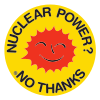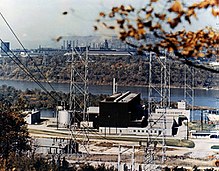History of the anti-nuclear movement
[9] Some local opposition to nuclear power emerged in the early 1960s,[10] and in the late 1960s some members of the scientific community began to express their concerns.
The project was cancelled in 1975 and anti-nuclear success at Wyhl inspired opposition to nuclear power in other parts of Europe and North America.
[14] In 1945 in the New Mexico desert, American scientists conducted "Trinity," the first nuclear weapons test, marking the beginning of the atomic age.
Also involved in the debate about nuclear weapons policy was the scientific community, through professional associations such as the Federation of Atomic Scientists and the Pugwash Conference on Science and World Affairs.
Exploding with a yield equivalent to 12,500 tonnes of TNT, the blast and thermal wave of the bomb destroyed nearly 50,000 buildings (including the headquarters of the 2nd General Army and Fifth Division) and killed approximately 75,000 people, among them 20,000 Japanese soldiers and 20,000 Korean slave laborers.
[15] Operation Crossroads was a series of nuclear weapon tests conducted by the United States at Bikini Atoll in the Pacific Ocean in the summer of 1946.
To prepare the atoll for the nuclear tests, Bikini's native residents were evicted from their homes and resettled on smaller, uninhabited islands where they were unable to sustain themselves.
The incident caused widespread concern around the world and "provided a decisive impetus for the emergence of the anti-nuclear weapons movement in many countries".
It highlighted the dangers posed by nuclear weapons and called for world leaders to seek peaceful resolutions to international conflict.
[7][8] In 1958, Linus Pauling and his wife presented the United Nations with the petition signed by more than 11,000 scientists calling for an end to nuclear-weapon testing.
The "Baby Tooth Survey," headed by Dr Louise Reiss, demonstrated conclusively in 1961 that above-ground nuclear testing posed significant public health risks in the form of radioactive fallout spread primarily via milk from cows that had ingested contaminated grass.
In the United States, the first commercially viable nuclear power plant was to be built at Bodega Bay, north of San Francisco, but the proposal was controversial and conflict with local citizens began in 1958.
[10] In 1966, Larry Bogart founded the Citizens Energy Council, a coalition of environmental groups that published the newsletters "Radiation Perils," "Watch on the A.E.C."
These publications argued that "nuclear power plants were too complex, too expensive and so inherently unsafe they would one day prove to be a financial disaster and a health hazard".
[32][33] The emergence of the anti-nuclear power movement was "closely associated with the general rise in environmental consciousness which had started to materialize in the USA in the 1960s and quickly spread to other Western industrialized countries".
[11] These scientists included Ernest Sternglass from Pittsburg, Henry Kendall from the Massachusetts Institute of Technology, Nobel laureate George Wald and radiation specialist Rosalie Bertell.
This initially centred on the state government's handling of the affair and associated police behaviour, but interest in nuclear issues was also stimulated.
[38] In Spain, in response to a surge in nuclear power plant proposals in the 1960s, a strong anti-nuclear movement emerged in 1973, which ultimately impeded the realisation of most of the projects.
[39] In 1974, organic farmer Sam Lovejoy took a crowbar to the weather-monitoring tower which had been erected at the Montague Nuclear Power Plant site.
[49][50] In 1986, hundreds of people walked from Los Angeles to Washington DC in the Great Peace March for Global Nuclear Disarmament.
[56] In May 2010, some 25,000 people, including members of peace organizations and 1945 atomic bomb survivors, marched for about two kilometers from downtown New York to the United Nations headquarters, calling for the elimination of nuclear weapons.













